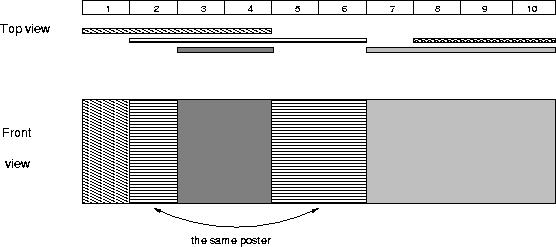The citizens of Bytetown, AB, could not stand that the candidates in the mayoral election campaign have been placing their electoral posters at all places at their whim. The city council has finally decided to build an electoral wall for placing the posters and introduce the following rules:
They have built a wall 10000000 bytes long (such that there is enough place for all candidates). When the electoral campaign was restarted, the candidates were placing their posters on the wall and their posters differed widely in width. Moreover, the candidates started placing their posters on wall segments already occupied by other posters. Everyone in Bytetown was curious whose posters will be visible (entirely or in part) on the last day before elections.
Your task is to find the number of visible posters when all the posters are placed given the information about posters' size, their place and order of placement on the electoral wall.
- Every candidate can place exactly one poster on the wall.
- All posters are of the same height equal to the height of the wall; the width of a poster can be any integer number of bytes (byte is the unit of length in Bytetown).
- The wall is divided into segments and the width of each segment is one byte.
- Each poster must completely cover a contiguous number of wall segments.
They have built a wall 10000000 bytes long (such that there is enough place for all candidates). When the electoral campaign was restarted, the candidates were placing their posters on the wall and their posters differed widely in width. Moreover, the candidates started placing their posters on wall segments already occupied by other posters. Everyone in Bytetown was curious whose posters will be visible (entirely or in part) on the last day before elections.
Your task is to find the number of visible posters when all the posters are placed given the information about posters' size, their place and order of placement on the electoral wall.
Input
The first line of input contains a number c giving the number of cases that follow. The first line of data for a single case contains number 1 <= n <= 10000. The subsequent n lines describe the posters in the order in which they were placed. The i-th line among the n lines contains two integer numbers l i and ri which are the number of the wall segment occupied by the left end and the right end of the i-th poster, respectively. We know that for each 1 <= i <= n, 1 <= l i <= ri <= 10000000. After the i-th poster is placed, it entirely covers all wall segments numbered l i, l i+1 ,... , ri.
or each input data set print the number of visible posters after all the posters are placed.
The picture below illustrates the case of the sample input.
The picture below illustrates the case of the sample input.

Sample Input
1 5 1 4 2 6 8 10 3 4 7 10
Sample Output
4
题意:每次从给定的位置a到b粘贴报纸,这次的可以覆盖上次的,问n次之后还能看见多少种。
思路:(在做这题之前最好先去了解一下线段树的染色问题,这里就不在赘述了)
区间修改问题,自然想到要用线段树,但看一下数据范围 10000000需要离散化一下。这题的离散化还有点小特殊,具体看下面的解释
例如先后覆盖 [1,10] [1,4] [6,10] 答案应该是 3
把这下节点都取下来 1 10 1 4 6 10;
排序去重 1 4 6 10;
重新映射
1 4 6 10
1 2 3 4;
离散化后的 [1,4] [1,2] [3,4] 。

可以看到第一次[1 4],第二次[1 2], 第三次[3 4],这样把[1 4]全盖死了,答案是2所以需要进行一下小优化
我们离散的时候来个判断,如果相邻数字间距大于1的话,就在其中加上任意一个数字,比如加成[1,3,4,5,6,7,10],这样的话离散就成功了;
具体看代码
for(int i=1; i<=n; i++) { scanf("%d%d",&le[i],&ri[i]); num[cnt++]=le[i]; num[cnt++]=ri[i]; } sort(num,num+cnt);//排序 tmp=cnt=unique(num,num+cnt)-num;//去重 for(int i=1; i<tmp; i++) { if(num[i]-num[i-1]>1) num[cnt++]=num[i-1]+1; }//+1
代码:
#include <iostream> #include <string.h> #include <string> #include<cstdio> #include <algorithm> #include<map> #define ll long long using namespace std; int ans=0,cnt=0; map<int,int>q; ll tree[800010]; void push_up(ll rt) { if( tree[rt*2+1]==tree[rt*2+2]) { tree[rt] = tree[rt*2+1]; } else tree[rt]=0; } void push_down(ll rt) //lazy的方法,本题比较特殊需要用tree数组代替add数据就行 { if(tree[rt]) { tree[rt*2+1]=tree[rt]; tree[rt*2+2]=tree[rt]; tree[rt] = 0; } } //板子直接套(注意该树是从节点0开始的) void bulid_tree(int node,int start,int end) { if(start==end) { tree[node]=0; } else { ll mid=(start+end)/2; ll left_node=2*node+1; ll right_node=2*node+2; bulid_tree(left_node,start,mid); bulid_tree(right_node,mid+1,end); } } //建树,递归的方法; void update_tree(int L, int R, ll key, int l, int r, int rt) //区间更新 L,R要查询的区间 { // cout<<"L="<<L<<" "<<"R="<<R<<" "<<l<<" "<<r<<endl; if(L<=l&&r<=R) { tree[rt]=key; //key 代表第几种报纸 return; } push_down(rt);//向下更新 ll mid=(l+r)/2; ll left_node=2*rt+1; ll right_node=2*rt+2; if(L <= mid) update_tree(L, R, key,l,mid,left_node); if(R > mid) update_tree(L, R, key,mid+1,r,right_node); push_up(rt);//向上更新 } void query_tree(int l, int r, int rt) { if(l==r&&!tree[rt]) return; if(tree[rt]) { if(q[tree[rt]]==0) //当节点不为0的时候代表在这个节点上有报纸,需要进项统计,在判断是否是第一次出现,如果是第一次出现就ans++. { ans++; q[tree[rt]]=1; } return; } // push_down(rt); ll mid=(l+r)/2; ll left_node=2*rt+1; ll right_node=2*rt+2; query_tree(l,mid,left_node); query_tree(mid+1,r,right_node); } int main() { int t; cin>>t; while(t--) { int le[10005],ri[10005],num[40005],cnt,tmp,n; q.clear(); cnt=ans=0; cin>>n; for(int i=1; i<=n; i++) { scanf("%d%d",&le[i],&ri[i]); num[cnt++]=le[i]; num[cnt++]=ri[i]; } sort(num,num+cnt); tmp=cnt=unique(num,num+cnt)-num; for(int i=1; i<tmp; i++) { if(num[i]-num[i-1]>1) num[cnt++]=num[i-1]+1; } sort(num,num+cnt); /*for(int i=0; i<cnt; i++) { cout<<num[i]<<" "; }*/ bulid_tree(0,0,cnt-1); for(int i=1; i<=n; i++) { int s=lower_bound(num,num+cnt,le[i])-num; int k=lower_bound(num,num+cnt,ri[i])-num; /*cout<<le[i]<<"**********************************"<<ri[i]<<endl; cout<<s<<"*********"<<k<<endl;*/ update_tree(s,k,i,0,cnt-1,0); } query_tree(0,cnt-1,0); cout<<ans<<endl; } }
最后离散化的代码我在单独放出来
for(int i=1; i<=n; i++) { scanf("%d%d",&le[i],&ri[i]); num[cnt++]=le[i]; num[cnt++]=ri[i]; } sort(num,num+cnt); tmp=cnt=unique(num,num+cnt)-num;//去重 for(int i=1; i<tmp; i++) { if(num[i]-num[i-1]>1) num[cnt++]=num[i-1]+1; } sort(num,num+cnt); /*for(int i=0; i<cnt; i++) { cout<<num[i]<<" "; }*/ bulid_tree(0,0,cnt-1); for(int i=1; i<=n; i++) { int s=lower_bound(num,num+cnt,le[i])-num; //建立左端点新的映射关系 int k=lower_bound(num,num+cnt,ri[i])-num; //建立右端点新的映射关系 update_tree(s,k,i,0,cnt-1,0); //用新的映射关系进想区间修改 }